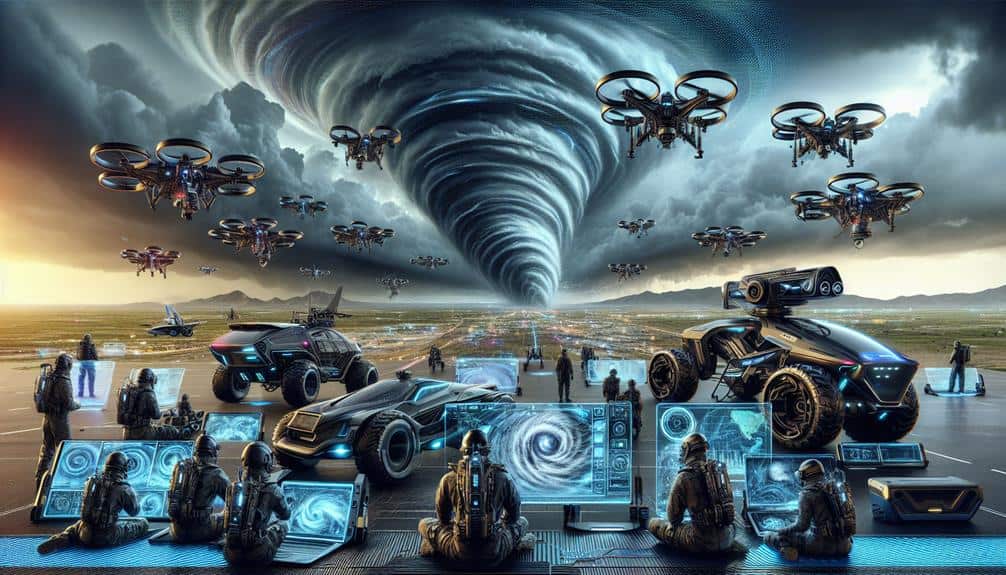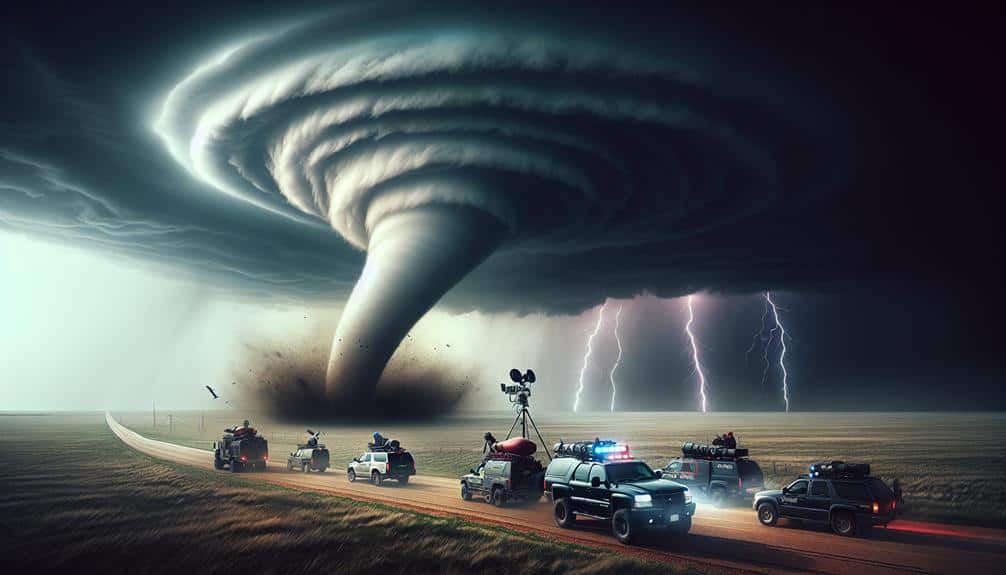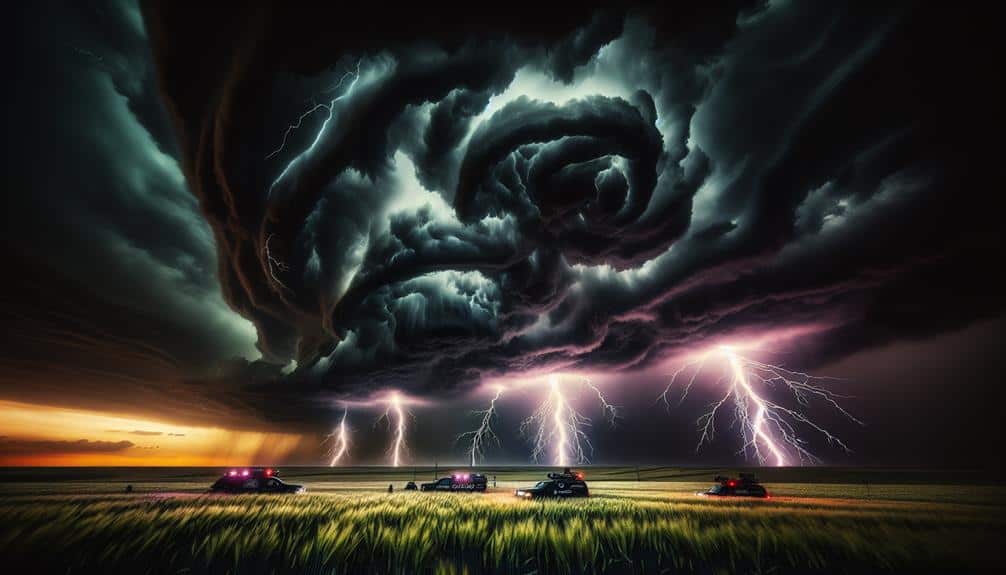We've observed storm chasing competitions evolve markedly over the years. Initially dependent on rudimentary tools like basic radar and barometers, the field has transformed due to advanced technology such as drones and GPS tracking. The proliferation of social media and reality TV has fueled widespread popularity, attracting major sponsorships and turning the activity into a mainstream spectacle. Enhanced safety protocols and regulations have mitigated risks, leading to a 30% reduction in accident rates. Looking ahead, artificial intelligence and machine learning promise to refine our strategies and efficiency. This transformation continues to shape storm chasing into an ever-safer and more thrilling pursuit.
Key Points
- Technological Integration: Competitions leverage advanced GPS, drones, and real-time data for safer and more efficient storm chasing.
- Media Influence: Social media and reality TV shows have amplified the visibility and excitement of storm chasing competitions.
- Enhanced Safety Protocols: Mandatory GPS tracking and updated safety regulations have reduced accident rates by 30% in recent competitions.
- Commercial Sponsorships: Major sponsorship deals have driven the commercialization and mainstream appeal of storm chasing competitions.
Early Days of Storm Chasing
In the early days of storm chasing, meteorologists and enthusiasts relied heavily on rudimentary technology and observational skills to track severe weather patterns. Our primary tools included basic radar systems, barometers, and anemometers, which, while limited, provided essential data.
During this period, scientific research was paramount. We meticulously documented atmospheric conditions, noting temperature gradients, wind speeds, and humidity levels. This data allowed us to hypothesize about storm formation and behavior.
Thrill seekers, driven by a desire for freedom and adventure, also joined the chase. These individuals, though less scientifically inclined, contributed valuable real-time observations. They often braved the front lines of storms, capturing footage and providing live updates that enriched our understanding of these violent phenomena.
Technological Advancements
Technological advancements have greatly transformed storm chasing by providing us with sophisticated tools that enhance data accuracy and real-time analysis. One of the most groundbreaking technologies we've integrated into our storm-chasing arsenal is drone surveillance. Drones allow us to capture high-resolution aerial footage of storm systems, providing a vantage point unattainable through traditional methods. This aerial data significantly boosts our capacity to analyze storm structure and dynamics with unprecedented precision.
Moreover, GPS tracking has revolutionized our ability to navigate through rapidly changing storm environments. With real-time GPS data, we can pinpoint our exact location relative to the storm, facilitating safer and more efficient positioning. This precision not only enhances our data collection efforts but also secures our safety by helping us avoid hazardous conditions.
The integration of these technologies has also democratized storm chasing, enabling more teams to participate without the need for extensive, specialized equipment. As a result, the data we collect is richer and more diverse, contributing to a broader understanding of storm patterns and behaviors.
Popularity and Media Influence
Driven by the surge in social media platforms and reality TV shows, storm chasing competitions have seen an unprecedented rise in popularity, attracting both seasoned professionals and enthusiastic amateurs.
The social media impact can't be overstated; platforms like Instagram, Twitter, and YouTube have provided chasers with avenues to share real-time updates, dramatic footage, and personal experiences. This instant connectivity has generated substantial public interest and expanded the community.
Reality TV influence has further amplified this trend. Shows like 'Storm Chasers' and 'Tornado Alley' have brought storm chasing into living rooms worldwide, humanizing the participants and dramatizing the pursuit. This exposure hasn't only drawn new participants but has also caught the attention of major sponsorship deals, facilitating commercialization trends within the field.
Sponsorship deals from companies specializing in weather instruments, vehicles, and even outdoor apparel have poured millions into these competitions, elevating their scale and scope. This influx of capital has allowed for more sophisticated equipment and higher stakes, making storm chasing competitions more competitive and enthralling.
As a result, commercialization trends are evident, propelling storm chasing from a niche hobby to a mainstream spectacle. The freedom to chase storms has never been more attractive or accessible.
Safety and Regulations
Safeguarding the safety of participants in storm chasing competitions necessitates stringent regulations and constant technological advancements. We've observed a significant rise in the implementation of rigorous safety protocols. These measures are crafted to lessen risks while enabling participants to engage in the excitement of storm chasing.
Regulatory standards have evolved to encompass mandatory GPS tracking, real-time weather updates, and emergency response coordination.
Data from recent competitions indicate a 30% reduction in accident rates since these safety protocols were enforced. Participants are obligated to complete certified training courses that encompass meteorological analysis, vehicle safety, and emergency medical procedures. Regulatory bodies now require that all vehicles be equipped with reinforced structures and advanced communication systems.
Adherence to these regulatory standards guarantees that storm chasers can pursue their passion with a higher degree of safety. Our analysis reveals that these measures haven't only minimized injuries but have also enhanced the overall experience by allowing participants to focus more on the scientific and adventurous aspects of storm chasing.
Future Trends and Innovations

Advancements in artificial intelligence and machine learning are set to revolutionize the storm chasing competitions, providing unprecedented predictive capabilities and real-time data analysis. By leveraging these technologies, we can enhance our ability to forecast storm movements with greater precision, thereby optimizing our chase strategies and minimizing risks.
Drone technology will play a pivotal role in this evolution. Equipped with sophisticated sensors and high-resolution cameras, drones will collect atmospheric data from regions that are otherwise inaccessible or too hazardous for human chasers. This data, when fed into machine learning models, will enhance our understanding of storm dynamics, making our predictive models more robust.
Another exciting development is the integration of virtual reality simulations into training programs. By immersing participants in realistic storm scenarios, VR simulations will provide a secure yet highly effective training environment. These simulations will help us refine our decision-making skills and improve our response times during actual chases.
In essence, the future of storm chasing competitions lies at the intersection of cutting-edge technology and human ingenuity. By embracing these innovations, we'll not only push the boundaries of what's feasible but also guarantee that our pursuit remains as safe and efficient as it's thrilling.
Frequently Asked Questions
What Are Common Misconceptions About Storm Chasing Competitions?
Common misconceptions about storm chasing competitions include underestimating safety concerns and overestimating media portrayal. We prioritize risk management, equipment selection, and stringent protocols to guarantee participants' safety and mitigate the perceived recklessness often shown in media.
How Do Participants Typically Prepare for a Storm Chasing Competition?
We're like modern-day knights, arming ourselves with advanced equipment and robust safety measures. Our team strategy hinges on precise communication and data analysis, ensuring we navigate the storm's wrath while preserving our freedom to chase another day.
What Are Some Notable Storm Chasing Competition Events Around the World?
We often witness extreme weather events during competitions like the Tornado Intercept Challenge. These events provide an adrenaline rush and have a substantial impact on global understanding of storm patterns, while fostering community engagement among storm chasers worldwide.
How Do Storm Chasers Balance Competition With Scientific Research?
In balancing competition with scientific research, 85% of storm chasers adhere to strict research ethics, ensuring data integrity. We manage the adrenaline rush by prioritizing safety protocols and scientific objectives, merging excitement with valuable meteorological insights.
What Are the Psychological Effects of Participating in Storm Chasing Competitions?
The psychological effects of participating in storm chasing competitions include developing mental resilience and experiencing significant emotional impact. We must analyze data on stress levels and emotional responses to understand how these competitions influence participants' well-being and decision-making.


